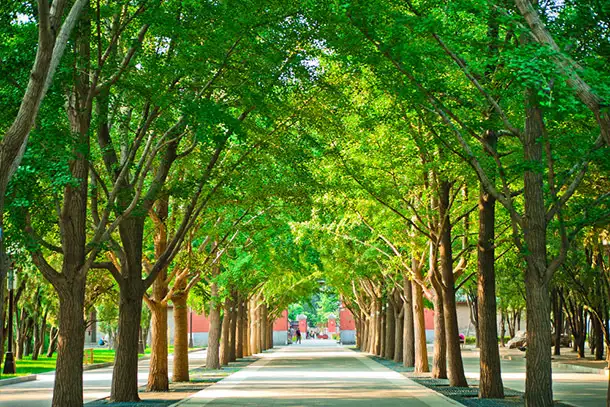
(Photo: Beijing, China via Shutterstock)
Not another ancient temple, I thought.
I’d already spent a week hiking along the ultimate ancient monument, the Great Wall of China, and a few days around Beijing exploring the Forbidden City, the Tibetan Yonghe Lamasery (or “Llama Temple”), and the royal tombs of the Qing Dynasty. After all that time among shrines to China’s ancient past, I was feeling a bit temple-d out.
I expected Beijing’s Temple of Heaven—where for centuries Chinese emperors from the Qing and Ming dynasties came annually to pray for good harvests—to be more of the same.
Turns out I had it completely wrong.
While the Temple of Heaven (literally “the Altar of Heaven”) is a huge complex of religious buildings similar to many of the shrines I’d already visited, it’s different because it’s surrounded by 660 acres of green space filled with tree-lined promenades and well-manicured grassy clearings. On the day I visited the Temple of Heaven, its most famous religious buildings were temporarily closed to the public to allow a visiting dignitary from some oil-rich Middle Eastern kingdom to tour them in private. I could have waited an hour or so for his entourage to clear the area, but something else called to me.
Something that sounded an awful lot like karaoke music.
The Temple of Heaven, it turns out, is an oasis among Beijing’s labyrinth of smoggy streets and high rises. The locals think of it like New Yorkers think of Central Park, but the vibe is distinctly Chinese. It’s a popular spot for choral shows, ethnic dancing, outdoor games, and daily exercise. When I visited on a random Wednesday morning in late May, the park was alive with people singing and dancing in loosely organized groups that encouraged participation.
And when I say it encouraged participation, I mean it: Yes, I danced with a gaggle of silk-clad middle-aged Chinese women; no, I’m not ashamed to admit I enjoyed it. I didn’t entirely understand what was happening at the time, but I now realize I was welcomed into an expressional dance routine where most of the participants belonged to one of China’s ethnic minorities. It was a surreal experience, and one I won’t soon forget—even if I can’t entirely explain how it happened.
This kind of thing goes on all around the Temple of Heaven. People practice tai chi in open spaces and play board games like mahjong under shady trees; and everywhere, they sing.
Occasionally a vendor will wander by selling heavily feathered shuttlecocks for a game called jianzi (think hacky sack but with clacking discs and feathers) and groups of locals will invite you to join them for a round or two. It’s fun and not nearly as easy as it looks. I paid about 50 cents for one of my own to take home. I’m hoping it’ll catch on in the U.S. someday.
It costs 35 Chinese Yuan (about $6 U.S.) for full admission to the Temple of Heaven park and religious buildings, and just 15 Yuan (about $2.50 U.S.) for the park only. That’s a small price to pay for a glimpse at a side of life in modern Beijing you might otherwise miss.
I never did get around to appreciating the triple-gabled architecture of the Hall of Prayer for Good Harvests. And I don’t feel like I missed out at all. If I ever find myself in Beijing again, I’ll plan to spend another morning at the Temple of Heaven.
After all, I’ve been practicing my jianzi.
You Might Also Like:
- Walking the Great Wall of China
- I Got Naked in a Turkish Bath
- The Strange History of America’s Most Dangerous Water Park
We hand-pick everything we recommend and select items through testing and reviews. Some products are sent to us free of charge with no incentive to offer a favorable review. We offer our unbiased opinions and do not accept compensation to review products. All items are in stock and prices are accurate at the time of publication. If you buy something through our links, we may earn a commission.
Related
Top Fares From
Today's Top Travel Deals
Brought to you by ShermansTravel
Porto to Lisbon: 7-Nt, Small-Group Portugal...
Indus Travels
 vacation
$1899+
vacation
$1899+
Greenland: Luxe, All-Incl. 11-Nt Exploration Small-Ship...
Swan Hellenic



Ohio: Daily Car Rentals from Cincinnati
85OFF.com





